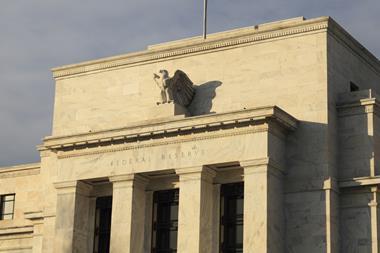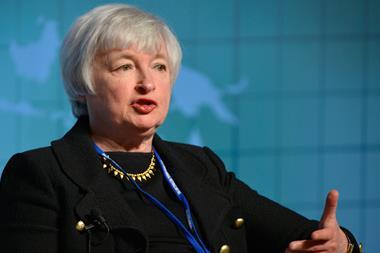Asset managers expect the US Federal Reserve to raise interest rates twice more this year after its rate-setting committee announced a 25 basis points hike last night.
The Federal Open Market Committee (FOMC) raised its target for the federal funds rate to 0.75%-1% in a statement yesterday, a move largely expected by investors. It was the second increase in four months, but just the third since 2008.
In the immediate aftermath of the FOMC’s announcement, yields on US treasury bonds fell dramatically. The FT reported 10-year bond yields fell more than 10 basis points, its biggest intraday fall since the US elections in November.
The majority of reactions from asset managers indicated they still expect two further increases this year, although some investors had expected more.
Rick Rieder, fixed income CIO at BlackRock, said the move towards positive real rates was “not only still extremely accommodative and economy/market supportive, but it brings the financial system closer to equilibrium”.
He predicted that the Fed’s move could be “the first stage in a cycle that will later this year see the European Central Bank discuss a more normalized rate policy”. The Bank of Japan could also make changes to its target for government bond yields.
“In our estimation, these are all healthy developments for the global economy,” Rieder said.
Others said the Fed’s future actions depended largely on the success of president Donald Trump’s planned fiscal stimulus measures.
Darrell Watters, Janus Capital’s US fixed income chief, said if Trump was unable to live up to his promises of fiscal stimulus it could force the Fed to remain “on a path of modest and gradual increases”.
Watters also cast doubt on expectations of two further rate increases this year, saying growth and inflation were likely to be “challenged” in the next few months.
“Without a pickup in wage pressures or a reacceleration of commodity prices, it is unlikely that inflation will increase at the pace of recent months,” he said. “A stronger dollar would also be deflationary and diminish the Fed’s inkling to further tighten.”
Luke Bartholomew, fixed income strategist at Aberdeen Asset Management, warned that it was “hard to imagine that the rest of this hiking cycle will go off without a hitch”.
“Over the last few years [the Fed has] consistently overestimated how many hikes it will deliver because the economy has turned out weaker than expected,” Bartholomew said. “But now the risk is that the Fed will need to catch up with easier fiscal policy and stronger growth outlook. Meanwhile, they’re facing increasingly shrill calls for their independence to be curtailed.”
Andrea Iannelli, investment director at Fidelity International, said yesterday’s move was positive for risky assets in the short term.
“The longer term picture, on the other hand, remains heavily dependent on the fiscal stance that the new US administration decides to adopt, although it may be difficult to pass any meaningful stimulus measure before next year,” he added.
Guy Plater, principal at Punter Southall Investment Consulting, said pension funds with unhedged exposure to US markets could benefit from a strengthening currency.
“Further comfort may also be taken from the fact that the early reaction from equity markets appears to be positive,” he added.
The S&P 500 climbed 0.6% yesterday, while the Dow Jones Industrial Average gained 0.4%.
Meanwhile in the UK, the Bank of England’s Monetary Policy Committee today voted to maintain its base interest rate at a record low 0.25%.











No comments yet